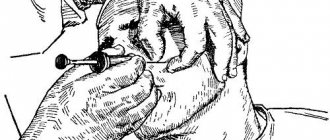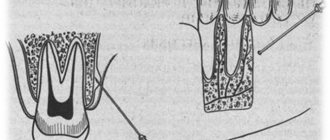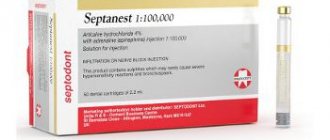Anesthesia during dental treatment is the main achievement of modern dentistry. Without local anesthesia, only the removal of superficial caries is carried out without affecting the pulp. If the patient is terrified of medical intervention, dental procedures are performed under general anesthesia. The article will cover the question of what torus anesthesia is and in what cases it is used.
What is torusal anesthesia
Methods of pain relief during dental procedures are selected depending on the type of intervention performed and the characteristics of the clinical picture. This can be either an injection of an anesthetic into the gum (infiltration) or covering a large area of the patient’s face - conduction anesthesia. With conduction anesthesia, a bundle of nerves that transmit pain sensations to the brain is blocked.
Since there are several nerves in the oral cavity, the impact is carried out specifically on the tooth adjacent to the diseased tooth. Thus, when treating molars of the lower jaw, mandibular anesthesia is performed, a variation of which is the torus method of anesthesia. With this method of pain relief, the mandibular nerves are blocked:
- inferior alveolar;
- buccal;
- lingual.
An anesthetic solution is injected into the junction point of these nerves - the torus. As a result of infiltration of the solution, complete anesthesia of the following facial areas occurs:
- chin;
- soft tissues of the lower jaw;
- their corresponding skin.
That is, sensitivity is lost at the level of the skeletal and muscular systems, as well as the skin. The effectiveness of pain relief allows you to begin medical procedures almost immediately after instillation of the product.
The advantage of the technique is that there is a large area of the facial region that is insensitive to pain. Disadvantages are the possibility of complications after the injection and the presence of a highly qualified dentist. The doctor must have knowledge of anatomical landmarks in order to find the right point for instillation without mistakes.
Painkillers used:
- lidocaine;
- ultracaine;
- novocaine
- trimecaine.
For serious surgical interventions that require a long time, other medicinal substances with an analgesic effect are used. Trimecaine is used to remove lower molars; it effectively blocks the dental nerves. It is also used for cleaning canals and filling teeth affected by caries.
If the chewing molars remain insensitive to the action of the medicine after the injection, the dentist performs additional anesthesia: saturates the mucous membrane around the sensitive molars with the solution.
Technique of “high” anesthesia of the inferior alveolar nerve
Carrying out standard mandibular anesthesia does not always provide sufficient anesthesia of the lower jaw, which can be explained by the presence of additional innervation. The teeth of the lower jaw can receive additional innervation from the hypoglossal, auriculotemporal and upper cervical nerves. The hypoglossal branch leaves the trunk of the inferior alveolar nerve approximately 1 cm above the mandibular foramen and therefore cannot be switched off using conventional techniques. Branches from the auriculotemporal nerve extend to the pulp of the lower teeth through openings in the ramus of the lower jaw. This innervation is blocked by “high” anesthesia according to GAGow-Gates and JOAkinosi.
When to use
The effectiveness and simplicity of torusal anesthesia allows it to be used in many cases of dental practice.
Torusal anesthesia is used for:
- opening of ulcers and abscesses in the lower jaw;
- extraction of mandibular molars;
- depulpation and other methods of intervention;
- installation of fixing splints in case of injury to the mandibular region;
- removal of molars with abnormal root locations;
- surgery for broken jaw bones;
- elimination of neoplasms;
- augmentation/removal of the jawbone.
Pain relief is also carried out in case of abnormal eruption of wisdom teeth, which is accompanied by severe swelling and pain. Incorrect growth of a wisdom tooth can cause rupture of gum tissue and cause severe complications.
The effectiveness of instillation depends on the qualifications of the dentist. To simultaneously block three nerves, you need to accurately hit the point of their connection, which is located in the torus. If the doctor cannot correctly determine the location of the torus, then it will not be possible to numb the desired area of the lower part of the face.
Incomplete pain relief can lead to discomfort during dental procedures. If the patient feels that there is insufficient blockage of the facial nerves, he should immediately inform the dentist.
Anesthetics used in this method may cause allergic reactions. Therefore, you need to warn your dentist about intolerance to certain medicinal components.
Allergic reactions to drugs are another problem with anesthesia. Since quite a large number of patients are intolerant to certain substances, pain relief can cause an unpredictable reaction in the body.
Advantages of the method
- The rapid onset of the effect of loss of sensitivity and blocking of nerve impulses.
- It is successfully used during caesarean section or to ease contractions during childbirth. Thanks to the safe effect on the patient’s body, the mother in labor does not have to worry about the health of the baby.
- A much smaller dose of the drug enters the patient’s body compared to other types of anesthesia.
- By using a thin needle when injecting the drug, the risk of internal damage is minimized.
- This anesthesia technique involves the muscles being as relaxed as possible, which greatly helps the surgeon during the operation.
- There is minimal intoxication of the body when the drug is administered, since the percentage of the anesthetic entering the blood is in isolated cases.
- The analgesic effect does not affect the respiratory system; therefore, problems associated with the lungs are automatically excluded, as is the case with general anesthesia.
- The patient remains conscious, which helps to immediately eliminate complications, since direct contact is maintained between doctors and the patient during the entire surgical process.
- Minimal risk of complications after puncture due to the simplicity of the anesthetic injection technique.
Spinal anesthesia has many advantages
Technique
Since the technique was developed by the Soviet dentist Weisbrem, it bears his name. In addition to Weisbrem’s technique, there are several more proven methods of torusal anesthesia developed by other experienced dentists - Legardi, Akinosi, etc.
According to Weisbrem
For the instillation of the medicine to be successful, the patient must throw back his head and open his mouth wide. During instillation, the syringe needle reaches the jawbone, so it should be held strictly perpendicular to the patient’s cheek. The success of pain relief depends on the correct location of the torus point.
The syringe needle is inserted into the soft tissues quite deeply and is located at the level of the first or second chewing molar. After inserting the needle, the medicinal composition is instilled in a volume of 1.5-2 cubes. To check that the needle has entered the blood vessel, the doctor draws a small amount of medication back into the syringe. The presence of blood in the syringe body indicates deformation of the blood vessel during instillation.
If everything went well, the doctor performs a block of the lingual nerve. No more than 0.5 ml of the medicinal composition is consumed to relieve pain. After 5 minutes, the patient should feel numbness in the mandibular region, and only after this can treatment procedures begin.
According to Akinozi
Using the technique, two nerves are blocked - the lingual and alveolar. The patient does not need to open his mouth wide; all manipulations are carried out with closed teeth. The doctor inserts the syringe needle into the point between the tubercle and the recess of the lower jaw. The volume of the drug is the same and is 1.5-2 ml. However, Akinosi anesthesia is used only in cases of ineffective blocking of nerve endings by other methods.
Despite the high effectiveness of pain relief, the method has the following risks:
- injury to the facial nerve;
- deformation of the periosteum;
- injury to the pterygoid and temporal muscles.
The Askinosi method requires a highly qualified dentist, as it is unsafe and traumatic. However, it is the Askinosie method that brings high-quality pain relief to patients who have two or more nerve endings in their molars.
According to Go-Gates
The anesthesia method was developed by Australian dentist Gou-Gates. It differs in that instillation is carried out in the corner of the patient’s lips. The syringe is inserted into the tendon of the pterygoid and temporal muscles and touches the jaw bone. After taking an aspiration sample (checking for the presence of blood in the solution), the dentist administers the medicinal composition in a volume of 1.5 -2 ml. Next, the patient should remain with his mouth open until the nerve endings are completely blocked. This takes no more than five minutes, although it is inconvenient.
Despite the inconvenience, using the Go-Gates method, several nerve roots are blocked at once:
- maxillohyoid;
- reed;
- temporal;
- buccal;
- lower lunula.
Complete blocking of the nerve roots occurs somewhat later than with other methods.
Improper instillation can cause spasm of the respiratory tract and hematoma formation. The method is one of the safest.
Intraoral methods of mandibular anesthesia
Anesthesia is carried out by palpating bony anatomical landmarks and using the apodactyl method (without palpation). Mandibular anesthesia by palpation.
To carry it out, it is necessary to palpate to determine the location of the retromolar fossa and the temporal ridge, which is a guide for inserting the needle. From the coronoid process to the lingual side of the alveolar process of the lower jaw, a bone ridge descends - the temporal crest (crista temporalis). In the lower section, this ridge is divided into internal and external legs, which limit a small triangular area - the retromolar triangle. Between the anterior edge of the ramus of the lower jaw, which passes downwards into an oblique line (linea obliqua) and the temporal ridge, there is a small triangular depression - the posterior molar fossa (fovea retromolaris). Bony landmarks are palpated with the index finger of the left hand if anesthesia is performed on the right, or with the thumb if it is performed on the left. With the patient's mouth wide open, the anterior edge of the lower jaw branch is felt at the level of the distal edge of the crown of the third molar (if it is absent, immediately behind the second molar). By moving the finger slightly inward, the temporal ridge is identified, the projection of which is mentally transferred to the mucous membrane. The finger is fixed in the retromolar fossa. Having positioned the syringe at the level of the small molars of the opposite side, the needle is inserted medially from the temporal ridge and 0.75-1 cm above the chewing surface of the third major molar. Advance the needle outward and backward. At a depth of 0.5-0.75 cm it reaches the bone. After releasing 0.5-1 cm of anesthetic solution, the lingual nerve, which is located anterior to the inferior alveolar nerve, is turned off. Having advanced the needle another 2 cm, they reach the bone groove (sulcus colli mandibulae), where the lower alveolar nerve is located before it enters the canal of the lower jaw. Here, 2-3 ml of anesthetic is injected to turn off this nerve. The branch of the lower jaw is not located strictly in the sagittal plane, but at a certain angle to it, with its anterior edge lying closer and its posterior edge further from the midline. The severity of the inclination of the branch varies in different patients. Therefore, having inserted the needle to a depth of 0.75 cm to the bone and turning off the lingual nerve, it is not always possible to move it deeper to the mandibular foramen without changing the initial position of the syringe. It often becomes necessary to move the syringe to the level of the central incisors and move the needle posteriorly parallel to the inner surface of the mandibular ramus to a depth of 2 cm towards the mandibular foramen and sulcus colli mandibular
Apodactyl method of mandibular anesthesia.
When performing anesthesia using the apodactylic method, the main landmark is the pterygomandibular fold (plica pterigomandibularis). It is located medially from the temporal ridge and can be wide, narrow, or have a normal (medium) transverse size. With the patient's mouth wide open, the syringe is placed at the level of the small molars or the first large molar of the opposite side. The needle is inserted into the outer slope of the pterygomandibular fold in the middle of the distance between the chewing surfaces of the upper and lower large molars (in their absence, in the middle of the distance between the ridges of the alveolar processes). The needle is advanced outward and posteriorly until it contacts the bone tissue (to a depth of 1.5-2 cm), after which 2-3 ml of anesthetic is injected to turn off the inferior alveolar and lingual nerves. Sometimes, having advanced the needle to a depth of 2 cm, it is not possible to achieve contact with the bone. This may be due to the indicated anatomical features of the mandibular ramus, when its inclination to the sagittal plane is significantly pronounced. In this case, the needle, when immersed in the tissue, moves parallel to the inner surface of the jaw branch, without touching it. Then it is necessary to move the syringe even further in the opposite direction, placing it at the level of the second molar. By changing the angle between the inner surface of the branch and the needle, it is possible to achieve its contact with the bone. If the pterygomandibular fold is wide, the needle is inserted into the middle, if it is narrow, into its medial edge. The pterygomandibular fold is a less reliable landmark than the temporal crest, therefore, with the apodactyl method of anesthesia, it is not always possible to accurately deliver the anesthetic solution to the inferior alveolar nerve.
Danger and risks
Pain-relieving procedures require highly qualified dentists and a certain amount of caution when performing them. Improper administration of torus anesthesia can lead to the following complications:
- fracture of a syringe needle followed by surgery;
- injury to blood vessels with subsequent bleeding and hematomas;
- paralysis of facial muscles, partial loss of facial mobility;
- injury to the fibers of the pterygoid muscles;
- loss of sensitivity of the oral mucosa;
- ischemia of the chin due to penetration of the drug into the bloodstream;
- infection of tissues with subsequent development of inflammation;
- neuritis of the mandibular nerves.
However, the patient must be careful after the dentist’s manipulations:
- sanitize the oral cavity in a timely manner;
- exclude rough foods until the mucous membranes are completely healed;
- take care of liver restoration.
Any anesthesia negatively affects the health of the liver, so the patient is obliged to independently take care of his own health and take prescribed medications or use other methods of restorative procedures.
Contraindications for carrying out
In what cases is local anesthesia of the oral cavity contraindicated or has partial contraindications? Anesthesia is prohibited for any liver pathologies, as it directly affects liver cells. Due to the high dose of novocaine, this method is excluded from the permissible method, and general anesthesia is recommended instead.
Also, torusal anesthesia is contraindicated for:
- intolerance to the components of the medicinal substance;
- pathologies of the circulatory system;
- mental disorders;
- bronchial asthma;
- cardiovascular pathologies;
- epileptic seizures.
Also, local anesthesia of this method is not carried out in case of anatomical disorders in the structure of the jaw and gums, as well as when the point of connection of the nerves is shifted.
Can this anesthesia be used during pregnancy? Permission must be given by the treating gynecologist, since the method may pose a certain danger to the fetus.
Bottom line
Torusal anesthesia is an effective means for quickly numbing a large area of the facial area. It is performed during complex dental procedures, when it is necessary to numb a large area of the facial region for a long time. With one injection, it is possible to immediately block three facial nerves that react acutely to pain.
However, performing the manipulation requires high medical qualifications, knowledge of the anatomy of the location of nerve endings, and careful handling of instruments. Improper administration of a drug can lead to various complications and injure the patient. The technique is used when other methods of blocking nerve endings are ineffective.
Sources used:
- Basic methods of pain relief at an outpatient dental appointment / Samedov Timur Islamovich. - M.: SpetsLit, 2011.
- Local anesthesia in dentistry / E.A. Bazikyan. - M.: GEOTAR-Media, 2012.
- Therapeutic dentistry. Anesthesia. Bleaching. Filling. Endodontics / Edited by E.V. Borovsky. - M.: Dentistry, 2005.
Torusal method of pain relief
Torusal anesthesia is a type of local anesthesia in which an anesthetic is injected into the mandibular ridge - the torus.
During the injection, the needle is in one position, which greatly facilitates mastering the technique. This method of pain relief was discovered in 1941 by M.M. Weisbrem. When an anesthetic is administered, the sensitivity threshold decreases:
The mandibular ridge looks like this
- mandibular region;
- chin area;
- alveolar process;
- facial skin;
- intraoral mucosa.
Thorusal anesthesia according to Weisbrem differs from standard mandibular anesthesia in that the needle is at a constant angle throughout the entire injection.









